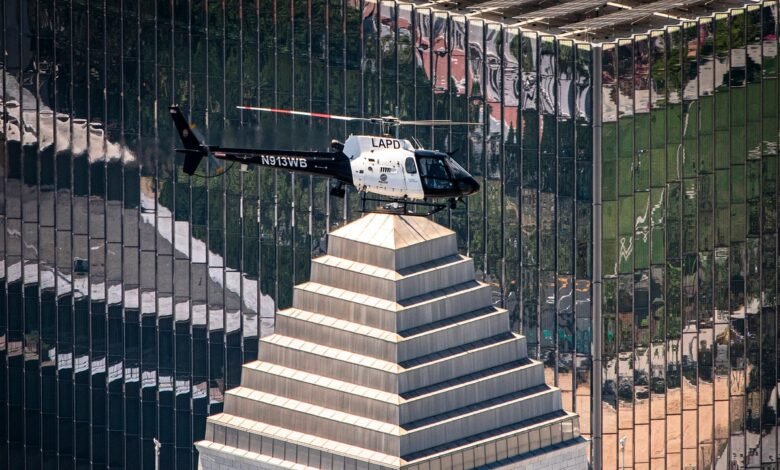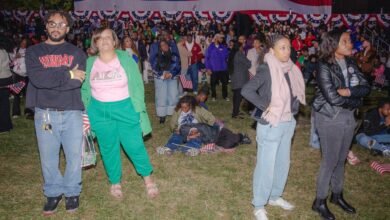Why the Noise of L.A. Helicopters Never Stops

The Jay Stephen Hooper Memorial Heliport sits on top of a brutalist brick-and-concrete building, the C. Erwin Piper Technical Center, across from Union Station in downtown Los Angeles. It’s an area where trains, buses, and highways all converge, and where the sounds of helicopters coming and going are barely noticeable above the din of engines and the smell of exhaust. From the ground, the heliport is barely visible. The best view of it is nearby, from the Cesar Chavez Bridge, over the Los Angeles River, which, in this part of the city, is just a low stream of water in a giant concrete aqueduct. From there, looking over a rail yard, one can see the helicopters parked at an angle on the roof, and the blinking of video monitors inside of an observation tower. On a recent evening, just before sunset, a police helicopter alighted, paused for a few minutes with its propeller spinning, then took off again.
The C. Erwin Piper Technical Center is the headquarters of the Air Support Division of the Los Angeles Police Department, which, according to the L.A.P.D., is the largest local airborne law-enforcement unit in the world. The division has seventeen helicopters in its fleet and more than ninety employees, and keeps at least two helicopters airborne for twenty hours a day or more, if deemed necessary. The aircraft are a constant part of the L.A. backdrop, like palm trees and traffic. A cluster of them hovering might indicate a crime or an accident, but one would have to be motivated to find out for sure. In addition to the L.A.P.D. patrols, there are also many news helicopters in L.A., plus the choppers of the Los Angeles County Sheriff’s Department’s Aero Bureau and of the Fire Department, and private helos ferrying the very wealthy. These other helicopters are identifiable on radar apps you can download onto your phone, but L.A.P.D. helicopters aren’t always labelled on these apps, which can make them difficult to track. They are often black with a white stripe down the middle, somewhat orca-like in appearance. At night, they blink with green and red lights, or beam blinding Nightsun spotlights toward the ground. The division’s mascot is a cartoon buzzard, in apparent honor of their tendency to circle. Rare is the day in central L.A. when you go without seeing one. They have made their way into movies—“Blue Thunder,” “Boyz n the Hood”—and into the city’s psyche.
The L.A.P.D. sent its first helicopter up in 1956 to monitor traffic. By the mid-sixties, particularly after the Watts rebellion, in 1965, Los Angeles law-enforcement agencies began experimenting with helicopter patrols, and the city’s aerospace industry began to lobby for their use. In 1968, the L.A.P.D., with the approval of NASA, commissioned Caltech’s Jet Propulsion Laboratory to conduct a study into the effectiveness of using helicopters “in a new role or phase of police work—specifically, as a patrol vehicle.” The researchers found that, in areas patrolled by helicopters, crime was lower than predicted, and that “no other changes within the police system were found that could account for these results.” The Air Support Division was established and expanded in the mid-seventies, a time of high levels of violent crime in the city. The division has remained in place ever since. “It all started here in L.A.,” Nicholas Shapiro, an assistant professor of biology and society at U.C.L.A., who is researching the health impacts of L.A.’s helicopter policing, told me, of a strategy that would go on to be adopted by cities around the country.
The Air Support Division makes up only about 1.5 per cent of the L.A.P.D. budget, but its high visibility and pervasive presence make it a personal issue for many residents. Dinah Manning, the director of public safety in the office of the Los Angeles city controller, told me she has memories of helicopters overhead dating back to her childhood in South Central, in the nineteen-nineties. Matyos Kidane, a community organizer with the Stop L.A.P.D. Spying Coalition, a Skid Row-based group that is pushing to dismantle police-surveillance capabilities, told me that, as a child growing up in an apartment without air-conditioning in the neighborhood of Mid City, he often had to decide on summer nights whether to shut his windows to the heat or to leave them open and try to sleep through the noise of police helicopters outside. As a teen-ager, he added, a police helicopter once followed him with its spotlight.
In the past few years, as public sentiment toward the police has shifted, the L.A.P.D. helicopters have also come under scrutiny. Following protests against police violence in 2020, a slate of progressive politicians won offices in city government by campaigning against the overfunding of the police. One of them was Kenneth Mejia, a thirty-three-year-old certified public accountant who, in 2022, was elected as the city controller. During his campaign, Mejia put up billboards on heavily trafficked streets with bar graphs comparing the three-billion-dollar L.A.P.D. budget with the city’s significantly smaller budget for housing and other priorities. Another billboard informed voters that around forty per cent of the taxes they pay on legal cannabis in the city was going toward the law-enforcement agency. The ads often featured one of Mejia’s two Welsh corgis, who now tend to appear on the covers of his office’s audits. Sometimes, they’re dressed as Sherlock Holmes.
Mejia announced an audit of the L.A.P.D. helicopter program shortly after taking office, at the beginning of 2023. The chief of accountability and oversight in the controller’s office, Sergio Perez—a civil-rights attorney who was appointed by Mejia—told me that the report was done in response to complaints by residents. “The concerns were chiefly, ‘Look, these helicopters, they’re over my particular house all the time,’ ” Perez said. “What’s the point? What’s it getting us and how much are we spending?”
The audit found that the helicopters cost around forty-seven million dollars a year, more than the operating budgets of fourteen city agencies—including the Department on Disability, the Department of Cultural Affairs, and the Department of Aging—and nearly the same amount that Los Angeles spends on the Department of Animal Services. The controller’s office calculated the cost of keeping the helicopters in the air at three thousand dollars an hour. It found that the program uses hundreds of thousands of gallons of jet fuel every year, contributes to noise and air pollution, and that a majority of the helicopters’ flights are not in response to high-priority crime but are instead for purposes such as general patrolling, transporting officials, and ceremonial flybys. (Recently, a man dressed as Santa Claus was strapped to the skids of a chopper and flown waving over a toy giveaway at a hospital.) The audit determined that helicopters targeted certain neighborhoods with disproportionate flight time. One predominantly Black and Latinx neighborhood, served by the 77th Street Community Police Station in South Los Angeles, received nearly ten per cent of the L.A.P.D.’s total helicopter flight hours. The audit also found “little evidence” to suggest that helicopters reduce or deter crime.




